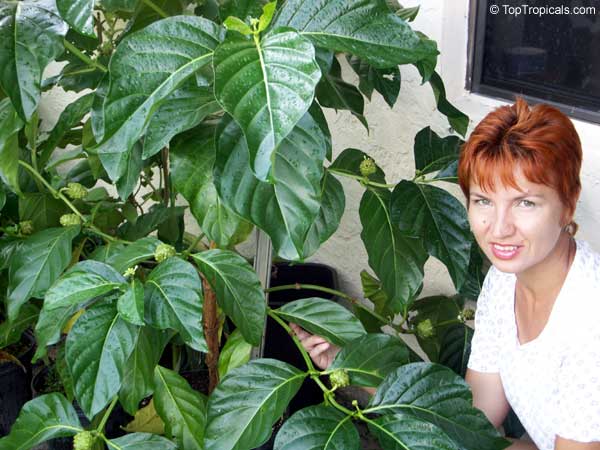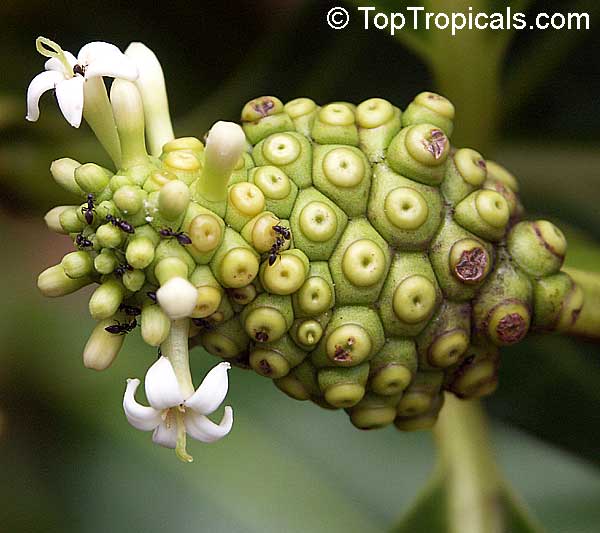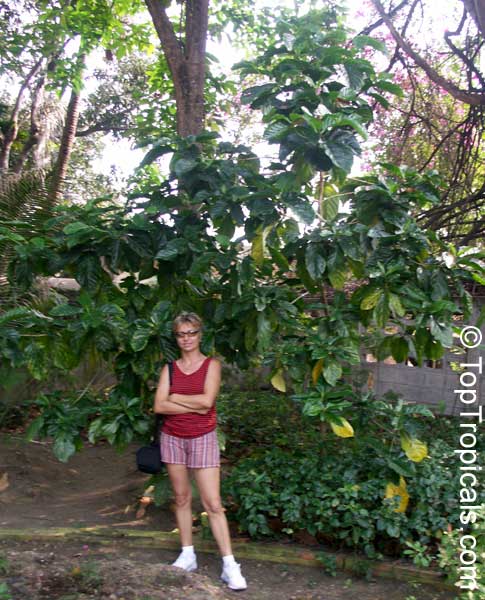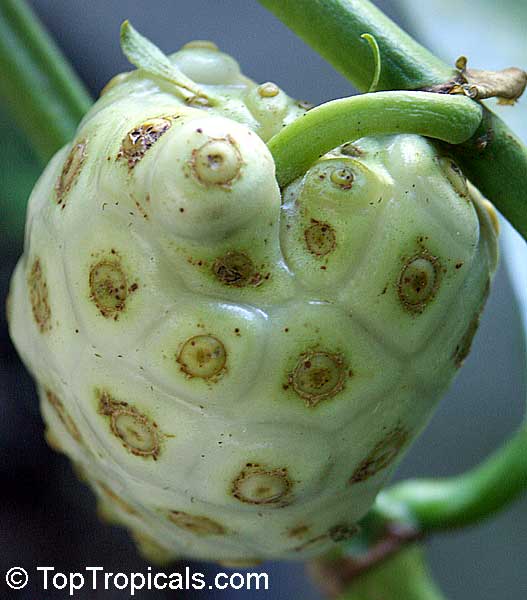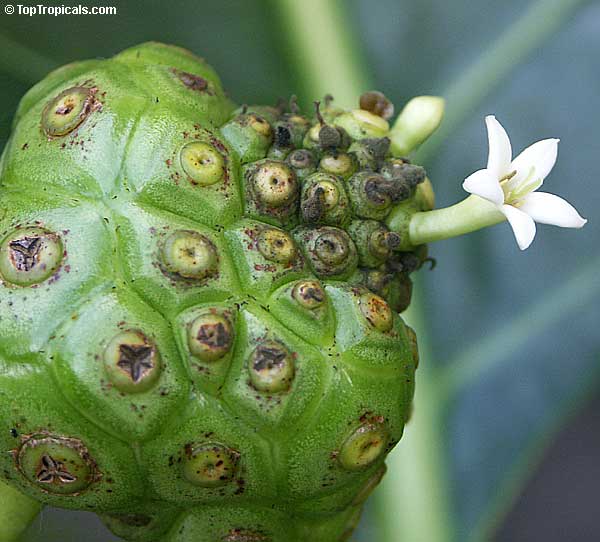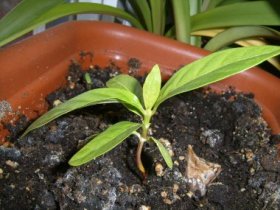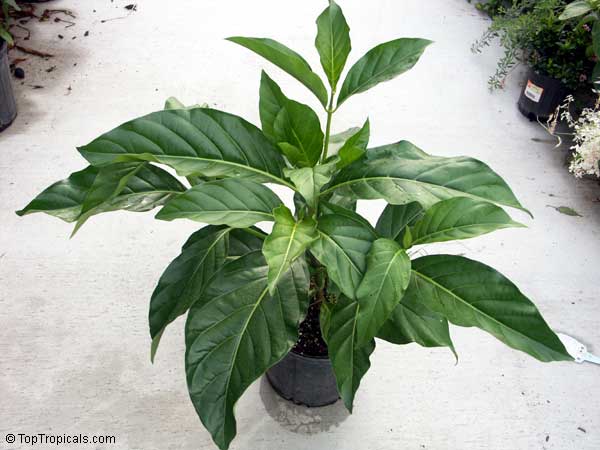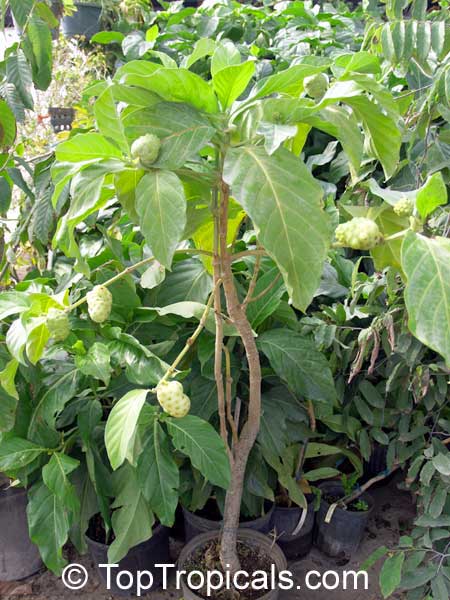Featured plant - a special for your collection
Morinda citrifolia - Noni: Life Sustaining Plant
Scientific name: Morinda citrifolia
Family: Rubiaceae - Coffee Family
Common name: Noni, Indian Mulberry, Cheese Fruit
Origin: Southeast Asia
Many people have heard about mysterious and miraculous Noni, but a few of them know axactly what it is. Originally this tropical fruit was only found in the South Pacific, but now becomes more popular due to its unique medicinal properties and easy cultivation.
Famous Healing Noni Juice is produced commercially and sold in bottles pretty expensive, while it is possible to grow this small tree not only in your yard, but indoors as well, and have a constant crop of fresh fruit. Besides, the plant is highly ornamental, with large, waxy tropical looking leaves and bushy habit. It can successfully replace a boring Ficus elastica sitting in your porch corner, and yet will bring you valuable oddly looking fruit, not only a conversation piece, but an everyday folk remedy as well.
Supposedly, Noni juice can cure just about anything and sometimes is considered as panacea. However, lets look into the history of this plant and watch how it was being used within the centuries as a traditional health-giving plant that is perhaps one of the most important natural health discoveries... We have so much to learn from the traditional use of this amazing beauty, every part of which is valued and used. Noni is a valuable plant to have nearby the home of anyone wishing to utilize the many natural healing properties of this remarkable life sustaining plant.
History
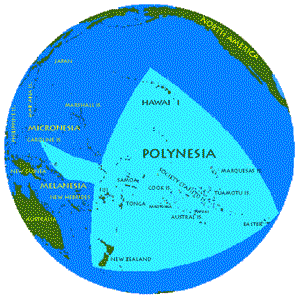 This plant is known among the people of the tropics worldwide. For thousands of years, only the islanders have known about it. In Malaysia, it is known as Mengkudu, in Southeast Asia - Nhau, in Samoa and Tonga - Nonu, in Raratonga and Tahiti - Nono, and it is called Noni in the Marquises Islands and Hawaii. Different people in tropics have more than 70 names for this plant, but “Noni” is the most world-widespread name now.
This plant is known among the people of the tropics worldwide. For thousands of years, only the islanders have known about it. In Malaysia, it is known as Mengkudu, in Southeast Asia - Nhau, in Samoa and Tonga - Nonu, in Raratonga and Tahiti - Nono, and it is called Noni in the Marquises Islands and Hawaii. Different people in tropics have more than 70 names for this plant, but “Noni” is the most world-widespread name now.
The Morinda citrifolia flourishes in the lush and unspoiled islands of French Polynesia, colonized islands throughout the South Pacific, the best known of these islands is Tahiti. It is considered to be one of the most beautiful plants in the islands and is a necessary addition to a traditional Polynesian garden.
In the islands of the South Pacific it is the most valued health-promoting plant, and is known among all peoples. Noni juice has been used by Polynesians for over 2000 years. It has become and integral part of the Polynesian Culture and was more widely used than any other medicinal plant, documented as a common medicine around the world in numerous cultures. The Noni Tree is widely featured in Hawaiian, Tahitian, and Tongan mythology. Native legends from Tonga and Hawaii include tales of the Goddess of Death killing the Demigod Maui. Maui was brought back to life in a sacred ceremony in which the leaves of the noni tree were placed on his body. Volcano Goddess Pele is also associated with noni, in that recent lava flows on the Big Island appear to have changed their course to spare old Noni trees. One enormous tree in Kalapana, estimated at over 300 years old, has three ladders stationed around it for harvesting a year round bumper crop of Noni fruit.
 In ancient times the inhabitants Tahiti island traveled long distances in large outrigger canoes with sacred plants from their
home islands for establishing new villages of their newfound paradise. These plants contained the basic foods, construction materials
and medicines used by the Polynesian colonizers. One of these sacred "canoe plants" (perhaps the most important
known) was the Noni, which they treasured as a gift from gods. Ancient manuscripts handed
down from generation to generation, describe many uses for this plant.
In ancient times the inhabitants Tahiti island traveled long distances in large outrigger canoes with sacred plants from their
home islands for establishing new villages of their newfound paradise. These plants contained the basic foods, construction materials
and medicines used by the Polynesian colonizers. One of these sacred "canoe plants" (perhaps the most important
known) was the Noni, which they treasured as a gift from gods. Ancient manuscripts handed
down from generation to generation, describe many uses for this plant.
The ancients revered and benefited from all the elements of the Noni plant - fruit, leaves, and seeds. It was an essential component of the Tahitian culture and folk healthcare that was used to sustain life and restore lost balance.
Long before settlers came to the Pacific Islands, there are records of noni being used as a health remedy in India.
Noni was first discovered and used long before recorded history in South East Asia and surrounded territiries, when ancient Indian scientists began examining the world of Nature and looking for plants good not only for food, but aslo to treat diseases and beneficial for health. They developed a medical system of using plants and natural treatments called Ayurveda, Sanskrit for "the science of life." A highly advanced system of natural medicine, Ayurveda is still being practiced today.
 Noni was considered a sacred plant and is mentioned in ancient texts as Ashyuka, which is Sanskrit for "longevity." Noni was noted to be a balancing agent, stabilizing the body in perfect health.
Noni was considered a sacred plant and is mentioned in ancient texts as Ashyuka, which is Sanskrit for "longevity." Noni was noted to be a balancing agent, stabilizing the body in perfect health.
When Europeans began exploring the islands of the South Pacific in the late 1700s, they noticed it was widely used by the native people. Captain Cook is his journals mentioned of his observation of the island natives using Noni for food and medicinally.
During World War II, U.S. soldiers based on Polynesian islands were instructed in their field manual that Noni was recognized as a safe food staple to eat to sustain their strength.
In the early 90s, food scientist John Wadsworth got wind of Noni fruit, and he went to Tahiti to find out more. What he found was a fruit high in antioxidants and rich in a history of helping people. He partnered with other scientists and spent nearly three years formulating Noni juice.
Since then, a new Noni’s life began. Today, millions over the world are discovering the health balancing properties of this once hidden island secret.
A Nature's Real Doctor
Noni has distinct chemical constituents which are responsible for its healing characteristics.
Compounds identified in Noni fruit are just unique:
Acetic acid, asperuloside, benzoic acid, benzyl alcohol, butanoic acid (n-butyric acid), I-butanol, n-butyric acid, calcium, carotene, decanoic acid, 6-dodeceno-y -lactone 8,11,14-eicosatrienoic acid, elaidic acid, ethyl decanoate, ethyl hexanoate, ethyl octanoate, ethyl palmitate, (ethylthiomethyl) benzene, eugenol, glucose, heptanoic acid, 2-heptanone, hexadecane, hexanamide, hexanedioic acid, hexanoic acid, 1-hexanol, hexyl hexanoate, 3-hydroxy-2-butanone, iron, isobutyric acid, isocaproic acid, isovaleric acid, lauric acid, limonene, linoleic acid, magnesium, 2-methylbutanoic acid, 2-methyl-2-butenyl decanoate, 2-methyl-2-butenyl hexanoate, 3-methyl-2-buten-l-ol, 3-methyl-3-buten-l-ol, methyl decanoate, methyl elaidate, methyl hexanoate, methyl 3-methylthio-propanoate, methyl octanoate, methyl oleate, methyl palmitate, 2-methylpropanoic acid, 3-methylthiopropanoic acid, myristic acid, nonanoic acid, octanoic acid, oleic acid, palmitic acid, paraffin, potassium, scopoletin, sodium, terpenoids , 2,5-undecadien-l-ol, undecanoic acid, n-valeric acid, vitamin C, vomifoliol.
Researchers throughout the world have studied Noni, bringing the secrets and benefits of the Noni plant to the peoples of the world. Noni’s reputable qualities are capturing the attention of scientists whose work and findings are published in some of the world’s most renowned journals. Research is revealing that all parts of the noni plant - roots, seeds, flowers, leaves, and fruit - have specific beneficial health properties. There seems to be no known food or herb with either the rich list of substances or the high amounts of key substances all put together in one super food. Noni aids the body’s natural healing abilities. It works like a food and acts like a medicine or herb without the side effects. This plant is a real doctor!
All parts of the Noni tree have so-called "proxeronine system" in them - a very important part of our immune system. In 1950 Dr. Ralph Heinicke PhD, a scientist and biochemist, lived in Hawaii discovered an alkaloid, which he named xeronine, an essential element for human health that is required for proper cellular communication and protein structure. The increasing use of artificial fertilizers in growing our food, as well as the increased pollution in our environment also negatively affects our intake of xeronine. Without this alkaloid, our body's cells become weak, resulting in weak tissues. Weak tissue causes weak organs. In turn, weak organs can lead to numerous health problems. As we age, our bodies produce less xeronine than is essential for our bodies to function optimally. Dr. Heinicke has found Noni to be one of the richest sources of proxeronine available. When proxeronine is present in the body, it accelerates the body’s ability to make sick cells better and to keep cells from getting sick in the first place. Scopoletin, another important ingredient in Noni, is known for its anti inflammatory, anti histaminic, improved circulation, anti-asthmatic, anti-bacterial and several additional important effects.
According to the resent research, Noni acts as an immune modulator. It may help in eliminating the allergy related symptoms by modulating our body immune system. Noni fruit does contain a number of enzymes (proteins) and alkaloids that are believed to play a pivotal role in good health. Research indicates Noni fruit stimulates the immune system, regulating cell function and cellular regeneration of damaged cells. Since Noni fruit seems to operate on the very basic and critical immunity level, hence may be useful for a wide variety of conditions. Scopoletin which is abundant in Noni juice is anti-histaminic nature. Hence it helps in eliminating the allergy induced symptoms like running nose, sneezing, itching of parts etc. The studies show that Noni stimulates the immune system, regulates proper cell function, increases the ability of cells to absorb and utilize nutrients, inhibits tumor growth, and regenerates damaged cells.Noni can be used as a supplemental cancer treatment and to reduce the side effects of chemotherapy. As a powerful antioxidant, it is used in therapy of AIDS / HIV.
The Noni seeds are a source of phospholipids, which are important in aiding your senses: touch, balance, hearing, taste. Research has shown that linoleic acid, an essential fatty acid, is a powerful ally in skin hydration and health. The seeds are especially rich in linoleic acid, which is absorbed easily through the skin.
Noni fruit can increase mental clarity and attention span, as well as allow greater physical performance levels. It also benefits the following systems of the body:
- Immune system. Supports the immune system's natural ability to fight disease and infection.
- Circulatory system, tissues, and cells. Superior antioxidant that helps rid the body of harmful free radicals. It also increases energy levels.
- Digestive system. Supports proper digestion and helps you absorb more nutrients at the cellular level.
- Contains components that are specifically important to the skin and hair. It also helps carry beneficial substances to the skin.
Today the basic Noni elements are used to create Noni juice products which are being used by thousands of people with unbelievable results. The formula is based on the ancient recipes of the islanders, is made from straight Noni fruit puree and includes grape and blueberry juice concentrates to enhance the flavor of the juice.
Botany of Dr. Noni
Noni is a member of the Rubiaceae plant family, It is native of South Eastern Asia to Australia.
In natural habitat this small tree reaches heights of 10-15, rarely 20 feet and yields fruit year-round. It has 4-angled stems, a straight trunk, large bright green, elliptical leaves. Thick and oval in shape, these leaves are deep veined, short-stemmed and 8 inches or longer.
The remarkable part is a small white tubular flower with its nectar being a favorite food of honey-eaters. The flower seem to appear on top of already formed ovoid, "grenade-like" fruit that grows and ripens very quickly. In fact, the flowers form in about an inch long globose heads bearing many small white flowers. The flower head grows to become mature fruit that is at first green, turning light yellow or off-white when ripe, with many seeds. The mature noni fruit resembles a small breadfruit. It can grow in size up to 4-5" or more, about the size of a potato and has a lumpy surface covered by polygonal-shaped sections.
The whole fruit is edible, but has somewhat unpleasant pungent smell when fully ripe, although the taste itself is not bad and resembles over-ripened sweet-and-sour pineaple flesh. However, the disagreeable odor is something one has to get used to if decides to eat a ripe fruit. Some people compare it with a smelly blue cheese (hence another name Cheese Fruit). Nevertheless, in some Pacific islands (Raratonga, Samoa, Fiji) the fruits were eaten raw or cooked as a staple food of choice. Elsewhere, the fruit is eaten raw with salt (Indochina, Australian Aborigines); or cooked as a curry. The young leaves can also be eaten as a vegetable and contain protein (4-6%). Seeds may be roasted and eaten.
Noni flowers are perfect, having both male and female organs within the same flower, so only one plant is necessary for harvesting. The plant is flowering and fruiting year around. Fruits used to gather seeds are traditionally harvested when they start turning white, or when they have turned fully soft, translucent, and become characteristically odorous.
Noni fruit have a large number of hard brown triangular shaped seeds the size of apple seeds. A single large noni fruit can contain well over 100 seeds. The seed coat is very tough, relatively thick, and covered with cellophane-like parchment layers forming a durable, water-repellant, fibrous seed coat or protective air sack that makes the seeds buoyant and gives them the ability to float in water for a long time. Although Noni originated in South East Asia and was distributed by humans into the islands of the Western Pacific, seeds could also have been distributed by floating in the ocean because of this air sac, and this could explain the wide distribution of the plant throughout the Polynesian islands. Seeds remain viable, even after floating in water for months.
Other Morinda RelativesMorinda are represented by over 80 species primarily of Old World tropical regions. The genus name derived from the Latin morus, mulberry, and indicus, Indian, in reference to the similarity of the fruit of Indian Mulberry to true Mulberry. Most popular species are Morinda citrifolia, Morinda trimera andMorinda reticulata.
Within the species Morinda citrifolia, there are two types: the large-fruit Noni with oval leaves (common in Hawaii) and the small-fruit Noni with elongated leaves (common in Micronesia). Morinda citrifolia var. potteri has variegated, green-and-white leaves.
Morinda trimera(Noni Kuahiwi, see pictures) is probably is most closely related to species of either the South Pacific or Malaysia. It resembles M. citrifolia but has smaller leaves and fruits. Some people incorrectly identify the two species Morinda described above as so-called “female” (Morinda citrifolia) and “male” (Morinda trimera) noni plants.
 Morinda reticulata or Mapoon Bush is a shrub with a thick, woody rootstock and grows 4-5 ft. The leaves are pale green, 2-4" long, thick and leathery in texture. It has a white flower with broad white sepals which look very showy in dark green background of leaves.
Morinda reticulata or Mapoon Bush is a shrub with a thick, woody rootstock and grows 4-5 ft. The leaves are pale green, 2-4" long, thick and leathery in texture. It has a white flower with broad white sepals which look very showy in dark green background of leaves.
Mapoon Bush growing on seleniferous soils are Selen-tolerant and accumulate very high concentrations of this element. Cattle, sheep and horses can be poisoned from eating Mapoon Bush containing excessive amounts of the trace element Selenium.
- Ach Awl Tree Ba Ji Tian
- Baga Bangkoro
- Beach mulberry
- Bengkudu laki-laki
- Bengkudu Bilimbi
- Bengkudu daun besar
- Boi Doieur Bumbo (Africa)
- Bungbo
- Bunuela Canary Wood (Australia)
- Canoe Plant
- Cheesefruit (Australia)
- Coca Doleur
- Dye Tree
- Feuille Douleur
- Feuille Froide
- Forbidden Fruit
- Fromager (French)
- Gardenia Hediona
- Gogu Atoni (Niue, Samoa, Tonga, Wallce, Futuna)
- Grand Morinda (Vietnam)
- Great Morinda
- Hog Apple Huevo de Reuma
- Indian Mulberry (English)
- Kesengel (Palau)
- Kura (Fiji)
- Lada (Guam, Northern Marianas)
- Ladda Leichhardt's Tree
- Lel (Palau)
- Limburger Tree
- Maddi chettu
- Mangal'wag (Yap)
- Mengkoedoe
- Mengkudi Besar
- Mengkudi
- Mengkudu Mirier de Java
- Molagha, Mona, Monii
- Mora de la India (Spanish)
- Morinda Citrifolia Linn
- Murier Indien (French)
- Nen (Marshall Islands, Chuuk)
- Ngel (Palau)
- Nhau Lon
- Nhau Nui
- Nhau Nho
- Nhor Prey
- Nhor Thom
- Nigua
- Nin (Marshall Islands, Chuuk)
- Nino
- Non (Kiribati)
- Nona Noni (Hawaii)
- Nono (Cook Islands, Tahiti)
- Nono Nonu (Niue, Samoa, Tonga, Wallce, Futuna)
- Nonu atoni (Niue, Samoa, Tonga, Wallce, Futuna)
- Nonu
- Nony
- Nuna
- Och Painkiller Tree (in Caribbean islands)
- Pina de Puerco
- Pinuela
- Polynesian Bush Fruit
- Pomme Macaque
- Rubarbe Caraibe
- Ruibarbo Caribe
- Togari Wood
- Urati
- Weipwul (Pohnpei)
- Wild Pine
- Yor Ban
When feeling really ill or really old...
Warning: Noni is a safe plant and a good edible fruit. However, a doctor should always be consulted concerning any symptoms of illness. The plant properties described here are not to be used without the recomendation of a suitably qualified specialist or doctor. Inappropriate use or abuse could severely damage your health.
It is said that this plant food is to be used when we are feeling really ill or really old.
For centuries, the Noni fruit has been used by native Polynesians for vitality and to ease pain and illness. The leaves of the Noni plant were used anciently to revitalize and soothe the body and to treat a wide variety of ailments. These include arthritis, boils, bruises, colds, constipation, cough, cut, diabetes, diarrhea, dysuria, ear infections, elephantiasis, enlarged spleen, eye infections, fevers, fractures, gastric ulcers, gout, headaches, hemorrhoids, inflammation, itching, menstrual disorders, muscle aches, neuralgia, pain, pneumonia, rheumatism, ringworms, septicemia (blood poisoning), small pox, sores, sore throat, sprains, stomach aches, styes, tetanus, and thrush. The leaves were also used as a tonic, emollient, deodorant, and a purgative.
Although it has been used in Polynesia for centuries, it has not been available in the Western market until now. Its great merit lies in the fact that its compounds work at the cellular level to stimulate cell regeneration and thereby increase cell function.
Noni increases the ability of our body cells to absorb and utilize vitamins, minerals, and other nutrients. It also has been shown to stimulate the production of T-cells within the immune system. Nowadays Noni is being used as a folk remedy to treat diarrhea, intestinal parasites, indigestion, stomach ulcers, coughs, asthma, respiratory afflictions, eye infections, fevers, flu, mouth and throat infection, sore gums, thrush, gingivitis, toothache, boils, diabetes, high blood pressure, headaches, menstrual cramps, arthritis, sprains, and the effects of aging.
Ethnic applications of the plant
This information is for education only and should not be used as a treatment guide unless recommended by a physician.
- Various parts are used to contain fever and as a tonic (Chinese, Japan, Hawaii)
- Various parts are used for treating eye problems, skin wounds and abscesses, gum and throat problems, respiratory ailments, constipation, fever (Pacific Islands, Hawaii)
- Various parts are used for treating stomach pains and after delivery (Marshall Islands).
- Heated leaves applied to the chest relieve coughs, nausea, colic (Malaysia)
- Juice from the leaves is taken for arthritis (Philippines).
- The fruit is taken for lumbago, asthma and dysentery (Indochina).
- Pounded unripe fruit is mixed with salt and applied to cuts and broken bones; ripe fruit is used to draw out pus from an infected boil (Hawaii)
- Juices of over-ripe fruits are taken to regulate menstrual flow, ease urinary problems (Malay)
- Fruits used to make a shampoo (Malay, Hawaii) and to treat head lice (Hawaii).
- Hot or wilted leaves are pressed on painful parts of the body; the leaves are poulticed to headaches. Crushed leaves in lard or camphor are placed on the head for head colds and neuralgia. (West Indies)
- The leaves and bark are used to treat malaria (Ailigandi)
- The fruit is eaten raw with salt (Indochina, Australian Aborigines); or cooked as a curry.
- Tongans used noni leaves to treat skin problems. Leaves were heated over the fire, ground and mixed with noni fruit, tiare flower, coconut, tamanu, and/or kukui nut oil.
- In Tahiti these antioxidant rich leaves were dried out and used internally as a tea to treat a variety of discomforts and to aid in digestion.
- Many other diseases treated with the plant by the islanders include venereal diseases.
- Polynesians used dried out and crushed up noni leaves to create a rudimentary form of tea. They used this noni leaf tea to treat a variety of discomforts.
- The fruit and its juices have been used in the treatment of diabetes, heart troubles and high blood pressure, with different portions prescribed for different illnesses. In these days of ozone depletion, Noni is useful in the treatment of skin cancers.
- Folklore of the ancient inhabitants of French Polynesia recounts the healing properties of the Noni leaf. Healers would place Noni leaves on deep wounds caused by coral shaft cuts in black pearl diving.
- Part of the stem was used to treat scorpion-fish puncture wounds.
- Children were fed noni leaves as a treatment for vitamin-A deficiency.
- A foetid oil was extracted from the syncarp and used in the hair as an insecticide.
- Juice from the fruit was used to make a medicinal drink, aumiki ‘awa, as a remedy for tuberculosis
- Noni seeds have been used to make an essential oil.
 The traditional Polynesians pick the noni before is it fully ripe and placed
it in a jar in the direct sunlight. After letting it set there for five days to a week or more, until the fruit turns
to mush and sun-charged juices drain into the bottom of the jar, these
juices that can be strained into a cleaner smaller jar, and then refrigerated
until used. When fully ripe, the noni fruit can be mashed into
a puree and the juice is extracted through a cloth. The juices can be diluted with clean water or a fruit juice such as apple or blueberry, and drunk before meals and at resting periods. Traditionally, the juice is taken during times of rest when the body
is under the least amount of stress, not before going to work.
The traditional Polynesians pick the noni before is it fully ripe and placed
it in a jar in the direct sunlight. After letting it set there for five days to a week or more, until the fruit turns
to mush and sun-charged juices drain into the bottom of the jar, these
juices that can be strained into a cleaner smaller jar, and then refrigerated
until used. When fully ripe, the noni fruit can be mashed into
a puree and the juice is extracted through a cloth. The juices can be diluted with clean water or a fruit juice such as apple or blueberry, and drunk before meals and at resting periods. Traditionally, the juice is taken during times of rest when the body
is under the least amount of stress, not before going to work.
Another method taught by Hawaian healers is to pick the fruit before ripe, letting it ripen at home. When soft, place it in a blender with a little fresh water and make into a sauce. Then mash and strain through a sieve. This mix can be refrigerated in a glass jar, and the medicine can be taken with a straw from the jar - two sucks in the morning and in the evening.
The Noni juice can be used with garlic, both being great blood purifiers that enhance the immune system and cleanse bacteria from the body. The healers mentioned boiling it for use with diabetes, and using it strained raw for heart problems and high blood pressure, as it is said to increase the flow of blood. Sometimes cayenne pepper is added as an ingredient as well.
There are those who eat Nonis fruit unripened as a tonic when needed. Green fruits are also used in curries.
Other people make a tea using the leaves. Leaves have been harvested to make noni leaf teas and salves. They used the leaves in food preparation, wrapping such things as fish to be cooked. Fish and other foods were wrapped in noni leaves before cooking in earthen ovens. The noni plant is prolific. Entire trees can be stripped of leaves and not only will the tree not die, but within months they will all return.
The young unripe noni fruit can be pounded thoroughly with salt and the mixture placed carefully on deep cuts and on broken bones. Sometimes the juice is squeezed out of this mixture, boiled and applied to the wounds. The ripe fruit can be used as a poultice for facial blemishes, rubbed until the oil disappears, and also to draw out the pus and core from an infected sore or boil, such as with a staph infection. The dressing of noni could be reapplied more than once for difficult cases.
In the Marquises Islands, the healing properties of the Noni leaf were tied closely to the demonstration of bravado and manly virtue found in tattooing the bodies of men. Tattooing was so painful and dangerous that many died in the process. But those who survived used elements of the Noni plant to assist in their recovery, and then offered Noni to the gods in sacred ceremony.
 Stories are told in Fiji of gravediggers eating Noni leaves before going out to perform their tasks and afterwards as a protection from evil spirits.
Stories are told in Fiji of gravediggers eating Noni leaves before going out to perform their tasks and afterwards as a protection from evil spirits.
The bark of the morinda produces a reddish purple and brown dye used in making batik and the tree was widely grown for this purpose in Java. In Hawaii, a yellowish dye was also extracted from the roots and also used to dye cloth.
The tree was also purposely planted to provide support for pepper vines and shade tree for coffee bushes.
It is used as a windbreak in Surinam.
Like other mangrove and shore plants, the morinda helps to stabilize the shore and provide shade under which other less hardy plants can establish themselves.
Noni fruits appear to attract the Weaver Ants (Oecophylla smaragdina), which also often make their remarkable nests out of the living leaves of the plant. In residence, these ants may protect the plant from insect predators.
Sprouted young seedlings
3 weeks old seedling
3 months old rooted cutting
Noni is a great patio plant
And yet so easy to grow!
Noni is an unusual plant, because it can easily tolerate and thrive in a wide range of soils and conditions.
The plant can take very wide range of light level, from full sun all day long to deep shade. In shade its large tropical leaves become even bigger and darker. Of course low light significantly reduce amout of flowers and fruit.
In natural habitat, Noni thrives with moderate watering and can survive extended periods of drought once established and mature. In contaner cultivation it prefers moist soil at all times, otherwise large meaty leaves start wilting down and may drop if growing medium is overdried. The good thing is - there are almost no chances to overwater this plant; it may easily stand in water for a while. Of course try to be reasonable, it is not in aquatics! Being relatively flood lolerant, Noni is a good choice for beginners, because owerwatering happens to be the main problem causing plant failure.
Noni tree grows well on sandy or rocky shores. Apart from saline conditions, it can withstand drought and grows in poor soils. The plant can be seen in clearings, volcanic terrain, lava-strewn coasts and on limestone outcrops.
Noni plants of all ages respond well to sprays of foliar fertilizers and should be fertilized frequently using smaller amounts of fertilizer, rather than infrequently using larger amounts. Noni may require frequent applications of small amounts of fertilizer. However, being salt-tolerant, it will also tolerate high levels of fertilizer salts in the root zone without damage or burning to the plant. Noni flower and fruit production is very responsive to sprays of high-phosphorous foliar fertilizers (e.g., 10-45-10) and other products containing nitrogen and minor elements.
No serious pest problems associated with Noni, although snales may like the delicious leaves whcih probably are as good for their health too!
You can grow Noni in your garden, as a patio or indoor plant. It is perfect for container and indoor culture, tolerates low light conditions (low light actually makes leaves darker, bigger and shinier) and will start fruiting on first year. Once started blooming and fruiting, it seems like it never stops popping out one fruit with flowers on it after another. You will be greatly rewarded for the simple care can provide an pleasantly surprised with its thriving and beautiful tropical look. This showstopper will always make a coversation piece of your plant collection.
The only requirement you must follow is absolutely warm conditions. Noni is a very cold sensitive plant, with a minimum temperature 55-60F to keep it happy. Below this temperature, leaves get some damage, and below 35-40 the plant may start wilt, leaves turn brown and drop; it may never recover and die if exposed to temperatures below 35F even for a few hours.
Noni is easy to propagate with seeds or cuttings.
Only soft, ripened noni fruits should be chosen for seed collection. Ripened fruits break up easily by hand, but the pulp clings to the seeds. The best way to separate seeds from the fibrous fruit flesh is cleaning them under a waterstrem in a colander. First, split the fruit by hand into smaller pieces. Some growers just plant fruit fragments containing seeds directly into the soil. However, we do not recommend it since the flesh may create a rotting environment. Separate the seeds from the flesh using a strong spray of water and a firm screen or colander, washing the pulp through the screen while retaining the cleaned seeds. Rubbing the fruit fragments on the screen can help force the fruit flesh through the screen. It may take a few minutes of vigorous washing and rubbing to detach most of the flesh from the seeds. Fresh Noni seeds should be planted immediately after extraction from the fruit and normally do not requre any specail pre-treatment, although it will be beneficial to soak them overnight in Cirkon solution which will improve germination rate and fight possible fungus. However, sometimes even fresh seeds take up to 5-6 weeks to germinate; but if conditions are favorable, and temperature high (80-95F), normally they start sprouting within 5-10 days. Scarifying the hard seed coat by nicking or puncturing it significantly reduces germination time. Unscarified seeds may require several weeks or even months before natural germination takes place, but their germination can be reduced by using bottom heat. Make sure to keep soil constatnly moist.
Cuttings root easily too. However, for stronger root system and healthier plant, it is recommended to grow Noni from seed. Seedlings and rooted cuttings take approximately the same time to start fruiting; let's put it this way - 2-3 months will not make a big difference unlike with many other tropical fruit that fruit readily on an air-layered small plant, and may take many years with a seedling.
Noni tree in its prolific beauty bears fruit year round as if to say, "Here I am, please use me!" Even if you are an immature gardener or just do not think that your thumb is green enough, you should try growing a Noni Tree, considering you can provide a warm environment for it. Replace that boring ficus in the corner with an exotic-looking Doctor Noni! It will brighten your home, and who knows - maybe some day will help you to get all better!
(compare with buying a single bottle of Noni Juice for $25-30)
Further reading:
- Noni Research
- Dr. Duke's Phytochemical and Ethnobotanical Databases
- World Noni Research Foundation
- Therapy Database: Noni Juice
- Noni is Good for You
Very tropical look! This plant is only 1 y.o., in 7 gal pot, sitting in a patio
A fruiting Noni indoors by a Christmas Tree
Fruiting Noni in 3 gal pot with a few fruit ripening on top of potting soil
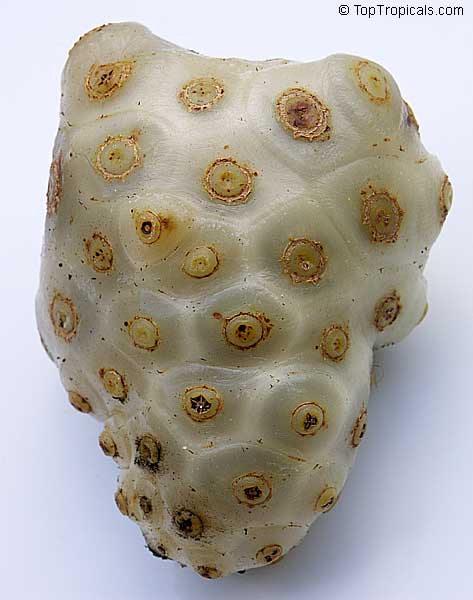
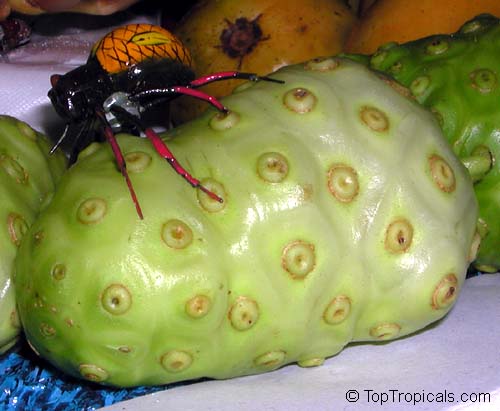
 VIDEO - Doctor Noni
VIDEO - Doctor Noni